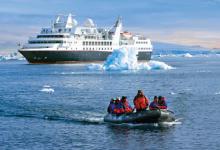Recently Viewed Cruises
- Silver Explorer, Voyage 7323 ex Colon to Puerto CalderaAdd to favourites
- Zaandam, Inca Discovery ex Ft Lauderdale to ValparaisoAdd to favourites
- Zaandam, Inca Discovery ex Ft Lauderdale to Buenos AiresAdd to favourites
- Coral, Panama Canal (Full Transit) ex Ft Lauderdale ReturnAdd to favourites
- Star, Panama Canal ex Miami to Los AngelesAdd to favourites
- Catch up on Cruising: Latest cruise news in bite size
- Oceania puts the flags out for Insignia
- Luxury cruising booms
- Catch up on Cruising: Latest cruise news in bite size
- Royal Caribbean International raises the bar
- Frequently Asked Questions
-
Silver Explorer, Voyage 7323 ex Colon to Puerto Caldera
Nights 7 Ship Silver Explorer Star Rating Specialty Departs Colon Panama Sailing 2013: 18 Oct Ports of Call Colon Panama, Panama Canal, Pearl Islands, Darien Jungle, Isla de Coiba, Golfito, Puerto Quepos, Puerto Caldera Please enquire about this cruise for pricing.
7 Night Cruise sailing from Colon to Puerto Caldera aboard Silver Explorer.
Silversea's purpose-built Silver Explorer expedition ship (formerly the Prince Albert II) has been designed specifically for navigating waters in some of the world's most remote destinations, including both of earth's polar regions. A strengthened hull with a Lloyd's Register ice-class notation (1A) for passenger vessels enables Silver Explorer to safely push through ice floes with ease. A fleet of Zodiac boats allows Silversea Expedition guests to visit even the most off-the-beaten path locations and an expert Expedition Team provides insight and understanding to each unforgettable Silver Explorer cruise adventure.
Onboard, savour a convivial cosmopolitan ambience and many special amenities usually found only on larger ships, including a spacious Library with an Internet Cafe, boutique shopping, a full-service spa, beauty salon, fitness centre, sauna and two top-deck whirlpools. Prince Albert II even features live evening entertainment and The Humidor, where connoisseurs can enjoy the finest cigars and cognacs - diversions offered by no other expedition ship.
Highlights of this cruise:
Colon
Colon (Spanish for Columbus), with its three modern ports, is one of the Caribbean's most important shipping terminals. It is connected to Panama City by road, rail, air and the Panama Canal. The Silver Whisper is scheduled to dock at the neighboring port of Cristobal, which features extensive facilities for cruise vessels and their passengers.
Colon is the second largest city in Panama with a population of just over 200,000. The city was founded in 1850 by Americans working on the Panama railroad and named Aspinwall for one of the railway engineers. Following completion in 1855, Colon gained in importance, which was furthered by the plans for an isthmian canal.
During the time of the French canal attempt, a fire in 1885 burned the city nearly to the ground and left thousands of people homeless. Colon was rebuilt in the architectural style then popular in France. Buildings from that era plus the ones constructed by Americans between 1904 and 1914 are still in use today, although the majority is on the verge of collapse.
In addition to its importance as a port, Colon boasts the world's second largest duty-free zone, known as Zona Libre, which is contained in a huge fortress like, walled-off area with giant international stores. However, most of the merchandise is sold in bulk to commercial businesses throughout the country. A top selection of Free Zone shops is located at Cristobal port, Pier 6, which also features an open market for Panamanian souvenirs, arts and crafts.
The port provides the base for a number of exciting shore excursions, including historical landmarks and spectacular nature.
Puerto Caldera
Costa Rica's major Pacific port on the Gulf of Nicoya provides visitors with the opportunity for trips into Costa Rica's interior, renowned for its unspoiled nature and beautiful scenery.
Costa Rica boasts a privileged location between two oceans at the southern end of Central America. It was discovered by Columbus in September of 1502 during his last voyage. Unfounded rumours of vast gold treasures led to the name of Costa Rica (Rich Coast). Spaniards from northern Spain settled mainly in the Central Valley. Independence from Spain was declared in 1821.
To supplement farming income, the government looked for a product that could be exported and taxed for revenue. It was found in coffee, introduced from Panama in 1791 with two bags of seeds. Costa Rica was the first Central American country to cultivate coffee in the rich volcanic soil of the Central Valley. Free land was offered to coffee growers, resulting in a peasant landowning class. In 1825, small quantities of coffee were carried on mule-back to the ports to be exported. By 1846, the transport was carried out in oxcarts. A few years later there was a substantial flow to overseas markets; this increased with the opening of a railway from San Jose to Puerto Limon on the Atlantic coast and the old port of Puntarenas on the Pacific. The country's economy is still based on coffee, followed by bananas, sugar and cocoa.
Costa Rica is considered Central America's most stable democracy. In 1949, the army was abolished and replaced by a very efficient-looking khaki-clad Civil Guard. Ticos, as locals are popularly called, are known for their friendly and outgoing attitude. The capital, San Jose, lies in the Central Valley at an altitude of 3,450 feet (1,062 metres), about a 2.5-hour drive from Puerto Caldera. Most of its colonial-era buildings were destroyed by earthquakes; the modern replacements are not very inspiring. The most attractive buildings include the National Theatre in the heart of the city and the Metropolitan Cathedral. The general sights can easily be viewed during a quick orientation drive. The real attraction lies in the countryside, which boasts sceneries of mountain ranges, lush valleys and quaint villages. Compared to the heat and humidity of the coastal area, the Central Valley is known for its pleasant, spring-like climate for most of the year.







